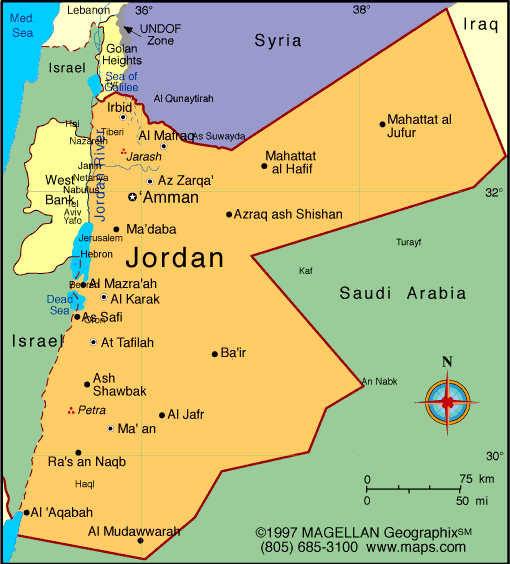Jordan Map: Regions, Geography, Facts & Figures
The Hashemite Kingdom of Jordan, often simply referred to as Jordan, is a captivating country in the Middle East. Nestled between the neighboring countries of Saudi Arabia, Iraq, Syria, Israel, and Palestine, it is a nation rich in history and culture. The capital city, Amman, stands as a testament to Jordan's proud heritage and vibrant modernity. A physical map of Jordan reveals a diverse landscape, from the Red Sea in the southwest to the Jordan River forming the country's western boundary.
If you want to discover more in-depth information on Jordan as a country, check out our Jordan Profile!
Plus, test your country knowledge with our World Map geography quiz on Geography Bee Questions!

History of Jordan
Jordan's history is as intricate as it is long. From its ancient past to its pivotal role with surrounding countries in the Arab-Israeli conflict, and even the Israeli-Palestinian conflict, the country has been shaped by various empires and civilizations. It's a place where maps show centuries-old borders overlapping with modern ones, and where cities like Al Karak bear witness to Roman, Arab, and Jordanian influences alike.
The country has been inhabited since prehistoric times, with evidence of settlements in the area dating back to around 9000 BC. During the Iron Age (1200–332 B.C.), Jordan became known as Transjordan and was part of a number of civilizations, including the Assyrians, Babylonians, Persians, Greeks, and Romans.
In 1516, it came under Ottoman control and was part of the Ottoman Empire for four centuries. After World War I, Transjordan became a British Mandate in 1922, with Abdullah I bin al-Hussein as Emir of the territory. In 1946, it gained independence as the Hashemite Kingdom of Jordan and full sovereignty from Europe’s rule came two years later.
Geography of Jordan
Located in Asia, specifically in the Middle East region, the Jordan map shows its country boundaries with Saudi Arabia, Iraq, Syria, Israel, the West Bank, and Palestine. However, Jordan also shares cultural and historic ties with its non-bordering neighbors, such as Lebanon and Egypt.
The geography of Jordan is diverse, featuring the Dead Sea, the Jordan River, the Gulf of Aqaba, and the Rift Valley. Major cities, including Irbid, Madaba, and Zarqa, dot the political map of Jordan. The capital city, Amman, lies in the northwest part of the country, and though not a part of Jordan, the religious city of Jerusalem is located just a short distance from the country, with the Jordan River forming a natural boundary.
Tourist Attractions in Jordan
Jordan is home to a number of historical sites, such as Petra, Jerash, Wadi Rum, and Umm Qais. Additionally, the country has several natural attractions, such as the Dana Biosphere Reserve and the Azraq Wetland Reserve. Diving in Aqaba's Red Sea provides visitors with an opportunity to explore one of the world’s most vibrant coral reefs. Tourists can also enjoy a range of outdoor activities, including hiking and camping in the Jordanian desert or visiting one of the country’s many national parks and major cities.
Amman, Jordan's capital city, is a blend of the old and the new. This bustling metropolis offers a mix of ancient ruins, modern architecture, vibrant markets, and mouth-watering cuisine. From the Roman Theater to the Citadel, Amman offers a taste of Jordan's rich history.
Petra, an ancient city renowned for its rock-cut architecture and archaeological sites, is Jordan's crown jewel. This UNESCO World Heritage Site is a must-visit location on any Jordan map.
Jordan is also home to numerous religious sites, such as Mount Nebo and Jesus’ baptism site at Bethany Beyond the Jordan. Overall, tourists are sure to find plenty of interesting attractions in Jordan during their stay.
People Also Ask…
If you're inspecting a Jordan map, you may have some queries about the region. Here are some of the most frequently asked questions, along with their answers.
Is Jordan Considered Africa or Asia?
Jordan is considered part of the Middle East and is located in both Asia and Africa. The majority of its territory is located in Asia, while a small portion lies within the African continent. Jordan has strong ties to both continents and serves as an important cultural bridge between them.
What Country Did Jordan Belong To?
Jordan has been an independent country since 1946. Prior to that, the region of Jordan belonged to a number of different powers including the Ottoman Empire, Great Britain, and France.
What Is The Primary Religion In Jordan?
Islam is the primary religion in Jordan with 97% of people identifying as Muslim. Christianity is also practiced by about 2% of Jordanian citizens.
What Is Jordan Famous For?
Jordan is famous for its incredible ancient sites, including Petra and Jerash. It is also known for its stunning desert landscape, world-class resorts, and vibrant culture. Jordan's capital city of Amman has become an increasingly popular tourist destination in recent years.
|
|








